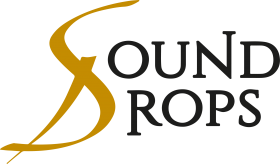SoundDrops
It's out!

...F for filters ... F for FREE!
HENRY-F - INDUCTOR-BASED RESONANT FILTER
HENRY-F INDUCTOR-BASED RESONANT FILTER is a free offering by SoundDrops, as an introduction to its bigger brother, Henry-Q.
It includes a High Pass and a Low Pass filter which are entirely based on real inductors. Essentially it is the filter section included in HENRY-Q (which in addition includes 2 filters, 4 eq sections and a transformer-coupled germanium stereo pre-amp stage).
Both the High-Pass and Low-Pass filters in HENRY-F have a 12dB/oct. slope with a continuous frequency control; they also display a unique feature, rarely found in other devices: a continuous Resonance control that adjusts the amplitude of an additional peak located near corner frequency, from 0 to a maximum of +3dB. It's a very effective sound-shaping tool.
One of the advantages of Acustica’s technology is that it allows to design and build processors whose realization would be quite impractical in the analogue domain. HENRY-F is a case in point, in that it includes a couple of inductor-based filters which offer a continuous control both for frequency and resonance, with a constant and predictable action throughout the range.
Henry-F is available for free here
Please note: all Acqua libraries released by 3rd party developers such as Henry-Q and Henry-F are loaded as programs inside N4 (formerly known as Nebula4) or N4Player.
The free N4Player can be downloaded here
or, even better, it can be installed through the assistant application Aquarius, available here.
MetaWare – Augmented Reality Acqua Libraries

MetaWare = Beyond the Hard/Software. A series of Acqua/Nebula libraries for N4 by SoundDrops based on an innovative concept. Proprietary hardware processors are specifically conceived, designed and built from the ground up with the creation of N4 libraries in mind.
Great care then is taken during the sampling and deconvolving process. Thanks to Acustica’s innovative technology, each aspect of the device’s behavior (frequency and phase response, harmonic and dynamic action and so on) can be separately sampled and then reassembled in an optimized form. The final outcome is a series of extremely clean and noiseless vectors, as it is easily apparent from the resulting response plots.
This procedure allows the creation of virtual machines that would be plainly impossible (or, at least, extremely unpractical) to build in the real world; a series of consistent and dependable digital processors that yet retain all the great sonic traits of real world analog hardware, down to the tiniest detail.
Handcrafted Acqua/Nebula Libraries

In my childhood years, while playing a toy guitar along a copy of Sgt. Pepper on my turntable, I knew exactly what I wanted to be: I imagined myself as an audio electronic engineer who played some music with his friends in his spare time. Things eventually evolved the other way round. Today I am a teaching and performing acoustic bass player who, in his spare time, still loves to tinker with electronic components, exploring the many ways in which they can beautifully shape any type of music thrown at them.
Few years ago I was lucky enough to meet the guys at Acustica Audio, an innovative Italian software house who are redefining the meaning of the term 'Plug-In' in the digital audio scene.
Their approach is sample-based, to the effect that almost any analogue audio processor can be analyzed, sampled and then digitally replicated by means of an advanced and proprietary form of dynamic convolution.
I was intrigued by this approach, and I knew that, despite my sketchy programming literacy, I could always rely on my pair of ears and my long-standing frequentation with audio electronics in order to achieve something good in this still almost uncharted territory.
Giancarlo Del Sordo, the master mind behind behind the company, asked me to work with them as an external collaborator/sampling expert for a number of Acustica products, such as Honey, Scarlet, Pearl, Emerald, Amethyst, Cobalt, plus several parts of many other plug-ins...
Then, last year Giancarlo conceived a new scheme for 3rd party developers to join the new Acustica marketplace along with their products. I surely didn't want miss such an opportunity, so here I am, at the very beginning this new adventure, hoping to bring some fresh perspective to the table.
I'm going to publish all the news, technical info, usage notes about my libraries in this space, so stay tuned and bookmark this page!
Contact Info
Mail me at sounddrops@stefanodallora.com
